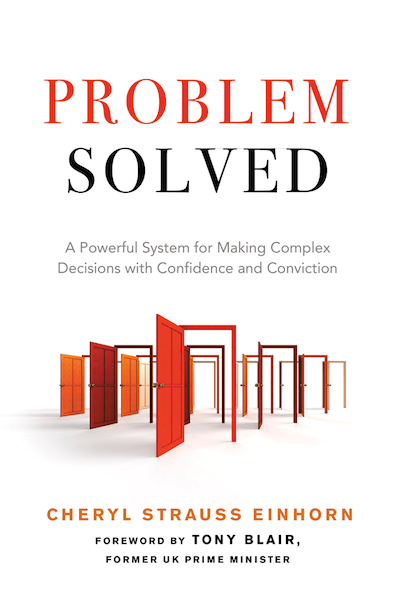If working around people and technology has taught me one thing, it’s that the soft stuff is the hard stuff. In other words, software code and machines almost always do what we tell them to do. People, on the other hand, are much less predictable. This is particularly true when decisions are unclear. What motivates one person at one point may not motivate that same person at a different point. And when dealing with different people with different priorities, just try applying consistent logic.
Against this backdrop, I recently sat down with Cheryl Strauss Einhorn, an award-winning journalist and an adjunct professor at the Columbia Business School. She is also the creator of the AREA Method and the author of the new book Problem Solved: A Powerful System for Making Complex Decisions with Confidence & Conviction.
Here are excepts from our conversation.
PS: What was your motivation for writing this book?
CE: Good decision making is a life skill that hides in plain sight. It’s never really taught — not in our schools and not in any well-established way. Imagine if every person learned it. Is there anything we do that has higher stakes than making good choices? I was thrilled with the response to a textbook I had written on my decision-making system — the AREA Method (an acronym for its four-stage process; Absolute, Relative, Exploration & Exploitation and Analysis) — for two very different populations: my investigative journalism students at Columbia University's Graduate School of Journalism and my Columbia Business School students. Both groups said that my AREA Method improved their approach to decision making, just as it had helped me in my own investigative journalism work writing stories for publications like Barron’s and Foreign Policy Magazine. AREA helps control for, and counteract, mental mistakes like assumptions and judgments, and my student populations also were finding that it enabled them to better evaluate the incentives and motivations of others. At its heart the AREA process of perspective-taking is meant to help you check your ego, enable you to better judge the incentives of others, and explore a situation more objectively. It also builds both self-awareness and empathy. As AREA becomes second nature, it can not only control for and counteract mental mistakes, it can be part of the frame you bring to the world around you. It may allow you to live your life more mindfully and enable you to take advantage of your ideas. With an effective and proven approach to decision making — a successful process — you can turn good ideas into great thinking.
PS: You note that certain people make decisions quickly. Yes this can be beneficial and even necessary but what are some of the downsides of deciding too quickly?
CE: Much has been written lately about how we are all prey to mental mistakes, what I call mental myopia. Behavioral science research and books like Robert Cialdini’s Influence and Daniel Kahneman’s Thinking Fast and Slow explain that we rely on faulty intuition and are swayed by authority and public sentiment, but they don’t give us tools or techniques to overcome our flawed thinking. Instead, this new research explores the many ways that we allow biases, snap judgments and assumptions to drive our decision making. While these pathways help us to make decisions quickly and easily, they impede our ability to think open-mindedly and thoroughly about complex problems. In other words, we know our thinking is flawed, but we don’t know what to do about it. AREA gives us a framework to proactively manage these flaws.

AREA moves you from one vantage point to the next, isolating and categorizing information based upon its source, enabling you to fully appreciate each perspective’s point of view and the incentives that shape it. Perspective taking acknowledges that although you may think that you understand how to solve a particular problem, your understanding of that problem is most likely incomplete and different from how other key players see it. By walking in their shoes, you will better recognize other player’s considerations and incentives. You may even come to understand the facts differently. But the method doesn’t just look closely at what others are doing and perceiving; it also guides you to look inward by taking you through a series of self-assessment exercises. I learned about these exercises from other disciplines including medicine, investigative journalism and intelligence gathering. They point out flaws in our own understanding of our research to highlight and help us catch – and correct for — failures of data and failures of analysis.

PS: Talk to me more about AREA. How can it help us make better decisions?
CE: AREA helps you make smarter, better decisions by improving upon classic research and decision making pedagogy in four important ways:
1. Recognizes that research is a fundamental part of decision making.
2. Solves the tricky problems of mental myopia — namely of assumption, bias and judgment — through its construction as a perspective taking process.
3. Addresses the critical component of timing head-on so that you have time for calculated and directed reflections that promote insight, slowing down to speed up the efficacy of your work.
4. Provides a clear, concise and repeatable process that works as a feedback loop in part or in its entirety.
We talked about the mental myopia piece above, so here let me explain a bit about the other three parts of AREA’s value proposition. In reality, your ability to make a thoughtful decision is dependent upon the quality of the information you have. This means you need a good research process to be an integral part of a decision making framework. Yet the current popular decision making books and tools often lump ‘do research’ or ‘evaluate your options’ into a single step. AREA recognizes that research is an umbrella term for a whole series of tricky steps that need to be carefully navigated and thoughtfully completed. The result: AREA breaks the research down so it’s not a ‘black box.’ Instead it’s manageable and organized into an easy to follow step-by-step logical progression.
In terms of addressing the critical issue of timing, the truth is that high-stakes decisions deserve time and attention but often we’re in such a rush to reach a conclusion that we never really take the time for deep reflection. We struggle with the need to react when we also need to really think. Yet when it comes to our future, we deserve the time needed for thoughtful reflection. Insight doesn’t come from collecting information alone; it comes from brainwork, so AREA builds in what I call ‘cheetah-like pauses.’ Why the cheetah? Because the cheetah’s prodigious hunting skills are not due to its speed. Rather, it’s the animals’ ability to decelerate quickly that makes them fearsome hunters. Cheetahs habitually run down their prey at speeds approaching 60 miles per hour but are able to cut their speed by nine miles per hour in a single stride. This allows the cheetah to make sharp turns, sideways jumps and direction changes. Like the cheetah’s hunt, the AREA Method offers both stability and maneuverability; it doesn’t consistently move forward. Instead, it benefits from calculated pauses and periods of thoughtful deceleration that enable you to consolidate knowledge before accelerating again. The reason: a quality research and decision making process is about depth, flexibility and creativity. The method’s cheetah pauses work as ‘strategic stops’ during and after each part of your research. They enable you to chunk your learning, prevent you from going off course, and provide a clear record of your work at each stage. But most importantly, they help home in on your motivation for making your high stakes decision and identify what’s most critical to you in the outcome.
PS: Understanding others’ motivations is never easy. Any tips for us here?
CE: AREA uniquely ferrets out the incentives of others through its construction as a perspective taking process. By focusing on others’ motivations and incentives you not only better understand their behavior, but also reflect a mirror back to how you’re thinking, feeling and acting. This perspective-taking helps you move from bias to objectivity and relates decision making with behavior — both other stakeholders’ and your own. You almost get a two-for-one. The result is that you solve your problems holistically, with empathy and understanding for the position of others.
